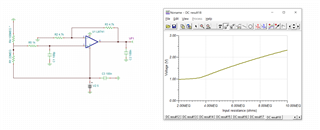Other Parts Discussed in Thread: TLV9001, LM358
Hello all,
I am currently working on the dynamic photoresistor which has a resistance ranging from 1 MEG - 300 MEG ohm. And I want to indirectly measure light intensity using the analog output..

I composed the circuit using the TINA and R4 is the dynamic photoresistor. In the simulation, it seems to work. However, in the breadboard simulation, I cannot read out signal correctly. And from the ESP32 or Arduino MCU boards, the analog signal was floating. So I tested very simple two serial 10 MEG ohm resistors testing.
a---- R1 (10 MEG) ---b--- R2 (10 MEG) ----c
Vac = 5V. However, Vab = 1.63 V, Vbc = 1.63 V which means that Vac not equal to Vab + Vbc. (I used multimeter).
Accordingly, my guess is that very low current due to high impedance can cause incorrect signal reading from MCUs and even multimeter.
Is there any circuit design or an electrical component that can solve this issue?
I have worked on this for a long time, however, I couldn't still fix it and feel little bit desperate.
Any kind of suggestions can be helpful and I am willing to try!
Thanks
Best
Seungjun

